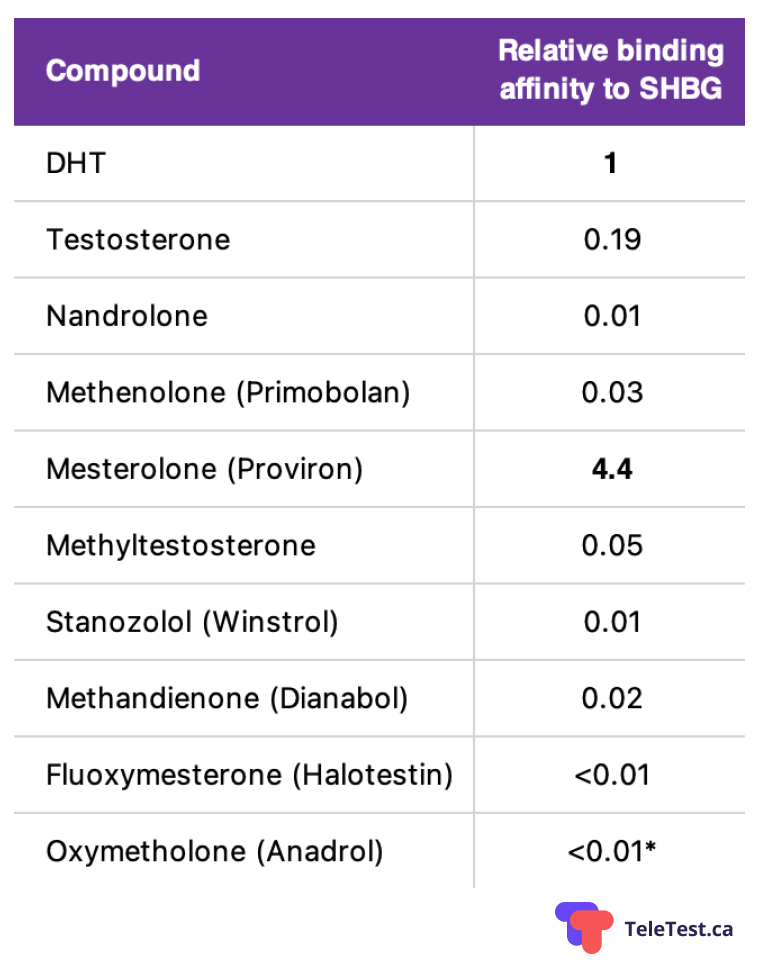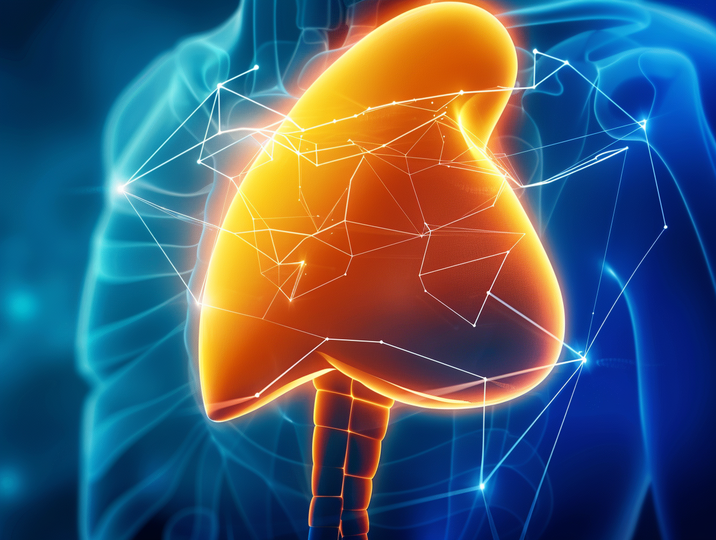Anabolic steroids, synthetic variations of testosterone, significantly reduce SHBG levels. When you take anabolic steroids, they signal your body to lower SHBG production. This reduction occurs through several mechanisms:
Direct Suppression of SHBG Production:
Anabolic steroids, particularly synthetic androgens like stanozolol, appear to directly inhibit the production of SHBG in the liver. This is similar to how endogenous androgens naturally suppress SHBG synthesis.
Increased Androgen Levels:
Anabolic steroids increase the levels of androgens in the body. High androgen levels signal the liver to decrease SHBG production because the body perceives an abundance of active testosterone, thus reducing the need for SHBG to transport and regulate these hormones. Lower SHBG levels increase the availability of free testosterone, the biologically active form that can bind to androgen receptors in tissues.
Negative Feedback Mechanism:
The hypothalamus and pituitary gland regulate hormone production through a feedback loop. Anabolic steroids introduce exogenous androgens that disrupt this loop, leading to decreased endogenous testosterone production and alterations in SHBG levels.
Alterations in liver function:
Anabolic steroids can affect liver metabolism, which may impact SHBG production since the liver is the primary site of SHBG synthesis.
Changes in insulin sensitivity:
Anabolic steroid use can affect insulin sensitivity, which is known to influence SHBG levels. Decreased insulin sensitivity is associated with lower SHBG levels
Binding Affinities
Different androgens and anabolic steroids have varying relative binding affinities to sex hormone-binding globulin (SHBG).

Differences in binding affinities to SHBG can affect the bioavailability and pharmacokinetics of various androgens and anabolic steroids in the body. Compounds with lower SHBG binding may have higher free fractions in the blood, potentially leading to greater biological activity or faster clearance.
Potential Consequences of Low SHBG
Low levels of Sex Hormone Binding Globulin (SHBG) can lead to a variety of side effects and long-term health consequences due to the disruption in the balance and regulation of sex hormones. Here are some key points to consider:
Side Effects of Low SHBG
Increased Free Testosterone and Estrogen:
- Acne and Oily Skin: Higher levels of free testosterone can stimulate sebaceous glands, leading to acne and oily skin.
- Hirsutism: Excessive hair growth in women, particularly on the face and body.
- Male Pattern Baldness: Accelerated hair loss in men due to increased androgen activity.
- Menstrual Irregularities: In women, low SHBG can lead to irregular menstrual cycles due to altered levels of free estrogen and testosterone.
Hormonal Imbalances:
- Gynecomastia: In men, increased free estrogen levels can lead to the development of breast tissue.
- Mood Swings: Hormonal fluctuations can cause mood instability, including depression and irritability.
- Libido Changes: Both men and women may experience changes in libido, either increased or decreased, due to altered hormone levels.
Insulin Resistance and Metabolic Issues:
- Low SHBG is often associated with metabolic syndrome, a cluster of conditions that increase the risk of heart disease, stroke, and diabetes.
- Type 2 Diabetes: There is a strong link between low SHBG levels and the development of insulin resistance and type 2 diabetes.
Long-Term Consequences of Low SHBG
Cardiovascular Health:
- Increased Risk of Cardiovascular Disease: Low SHBG levels have been linked to a higher risk of developing cardiovascular diseases, including hypertension, atherosclerosis, and heart attacks.
- Lipid Profile Alterations: Hormonal imbalances can affect lipid metabolism, potentially leading to elevated cholesterol levels and an increased risk of cardiovascular issues.
Bone Health:
- Osteoporosis: Reduced SHBG can lead to lower levels of bound estrogen, which is crucial for bone density maintenance. This can result in an increased risk of osteoporosis and fractures, especially in postmenopausal women.
Reproductive Health:
- Infertility: Both men and women may experience fertility issues due to imbalances in free hormone levels. In men, low SHBG can lead to decreased sperm production, while in women, it can affect ovulation.
- Polycystic Ovary Syndrome (PCOS): In women, low SHBG is often associated with PCOS, which can cause irregular periods, infertility, and other metabolic complications.
Cancer Risk:
- Prostate Cancer: Increased levels of free testosterone and estrogen have been associated with a higher risk of developing prostate cancer in men.
- Breast Cancer: Women with low SHBG and high levels of free estrogen may have an increased risk of developing breast cancer.
How to Increase SHBG?
Lifestyle and Dietary Changes
Maintain a Healthy Weight:
- Being overweight or obese can lower SHBG levels. Adopting a balanced diet and regular exercise can help manage weight and potentially increase SHBG.
Increase Insulin Sensitivity:
- Eat a diet that promotes insulin sensitivity (foods with low glycemic index)
- Avoid refined carbohydrates
- Metformin, a medication for diabetics, may improve insulin sensitivity
Increase Physical Activity:
- Regular aerobic exercise and resistance training can positively influence hormone levels and may increase SHBG.
Healthy Diet:
- Focus on a diet rich in vegetables, fruits, whole grains, lean proteins, and healthy fats.
- Avoid excessive consumption of sugars and refined carbohydrates.
Reduce Alcohol Intake:
- Excessive alcohol consumption can negatively affect liver function and SHBG production.
Manage Stress:
- Chronic stress can alter hormone levels. Techniques such as meditation, yoga, and other relaxation methods can help manage stress.
Nutritional Supplements and Medications
Vitamin D:
- Adequate levels of Vitamin D have been associated with higher SHBG levels. Consider Vitamin D supplementation if you have a deficiency.
Increase Fiber Intake:
- Diets high in fiber, particularly from vegetables, fruits, and whole grains, have been linked to higher SHBG levels.
Soy Products:
- Some studies suggest that phytoestrogens found in soy can increase SHBG levels.
Certain Medications:
- Some medications, like oral contraceptives containing estrogen, can increase SHBG levels. However, this should be discussed with a healthcare provider.
Avoid Oral Steroids:
- Avoid most oral steroids, especially Proviron
Hormonal Influence
Estrogen:
- Estrogen therapy, under medical supervision, can increase SHBG levels.
- Avoid aromatase inhibitors
- Low doses of SERMs (not tamoxifen) may increase SHBG
Medical Conditions
Address Underlying Health Issues:
Certain medical conditions, such as hypothyroidism and liver disease, can affect SHBG levels. Proper diagnosis and treatment of these conditions may help normalize SHBG levels.
Monitoring and Medical Advice
Regular Check-ups:
Regular blood tests and check-ups with a healthcare provider can help monitor SHBG and overall hormone health.
Monitoring Sex Hormone-Binding Globulin (SHBG) levels is particularly important for individuals using anabolic steroids. Anabolic steroids can significantly alter SHBG levels, impacting the balance and availability of key hormones such as testosterone and estrogen. These changes can lead to various side effects, including hormonal imbalances, liver damage, cardiovascular issues, and reproductive health problems. Regular monitoring of SHBG can help detect these alterations early, allowing for timely adjustments in steroid use and implementation of protective measures to mitigate potential health risks. Therefore, keeping track of SHBG levels is essential for the safe and effective use of anabolic steroids.
Disclaimer: This blog post is intended for educational purposes only and should not be taken as medical advice. Always consult your healthcare provider for personal health concerns.
